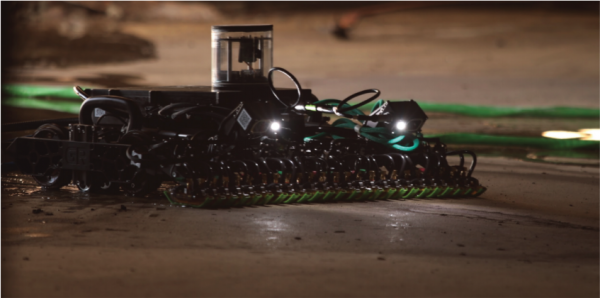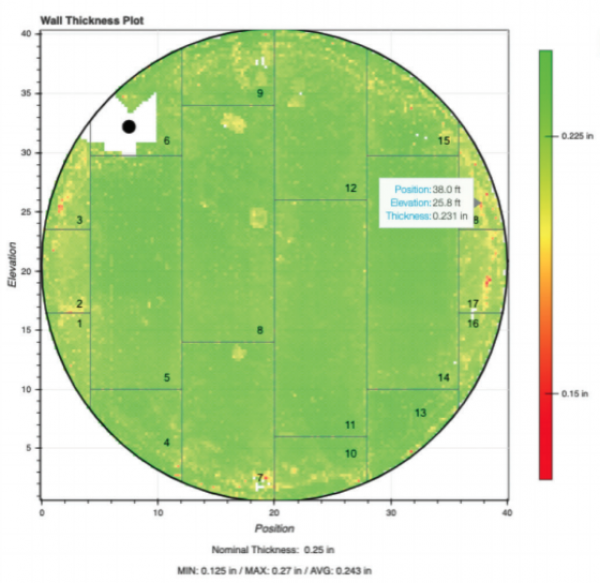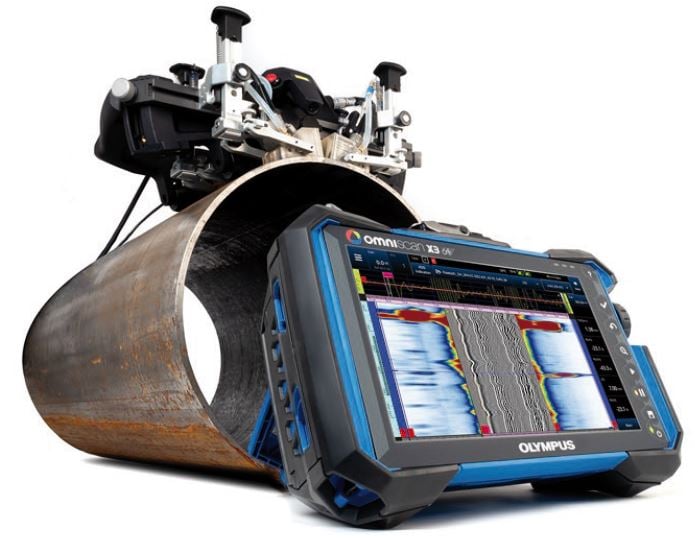Rapid Ultrasonic Gridding (RUG) is a nondestructive examination (NDE) method of performing ultrasonic thickness in which multiple ultrasonic thickness probes are utilized, simultaneously, to rapidly gather thickness measurements in a predefined or ad hoc space. Like other ultrasonic testing (UT) methods, RUG captures raw A-Scan data, which can be presented in B-Scan or C-Scan modes — or used to create visual representation as 3-D models. However, RUG is capable of capturing multiple A-Scan data points at a much faster rate than traditional thickness measuring techniques.
History and Development
Traditionally, ultrasonic thickness gridding has been utilized for monitoring localized corrosion or locally thinned areas of piping and equipment. These grids provide enough detail to make decisions about the future monitoring, repair, or replacement of an asset.
Historically, grids were gathered manually using a single ultrasonic transducer. The thickness readings and accompanying A-scans were gathered and reviewed for each location. As inspection tools evolved, the B-scan was developed, producing a dense linear accumulation of A-scans. The locations of the readings were recorded using an encoder.
The big data evolution, combined with the introduction of robotics in the industry, has allowed for a way of gathering multiple B-scans in a single scan to produce a C-scan corrosion map at a rate exponentially faster than with a single transducer. This is all done in addition to the existing benefits of UT, such as capturing A-scan data for post-inspection data validation.
Techniques and Methodology
RUG tools utilize multiple thickness probes, anywhere from 4 up to approximately 100 probes at a time. As such, the speed of coverage is greatly increased over methods utilizing a single thickness probe. The spacing of the probes and the frequency of recording varies depending on the amount of thickness data needed.
RUG can be performed using manual scanners or robotic crawlers. With robotics and nearly 100 thickness probes at a time spaced at ¼” apart, millions of data points with A-scans can be gathered in a matter of days.
RUG does not rely on manual grid marking for determining the location of the thickness data. The use of encoders allows for pinpoint repeatability and prove-up of RUG findings.
Industry Applications
RUG is primarily utilized for finding and determining the extent of localized thinning, corrosion monitoring, or identifying HIC/SOHIC damage. HIC/SOHIC indications require follow-up with ultrasonic shear wave testing (UTSW) or other crack measuring methods.
RUG can be used to replace the manual 1” x 1” UT grid method and single-transducer automated UT methods that are typically performed for corrosion monitoring.
RUG data can be utilized to satisfy the fitness for service (FFS) criteria found in API 510 or API 579 for determining the suitability for continued service of a locally thinned area, localized and scattered pitting, and areas below t-min. In addition, RUG can be performed to satisfy the inspection confidence requirements to reduce risk, in accordance with API RP 580 and API RP 581.
RUG can be utilized for mix-point and injection point inspections to capture nearly 100% thickness coverage of mix-point and injection-point circuits, going far beyond standard best practices.
RUG can be utilized for a quantitative inspection of tank floors by providing thickness corrosion mapping of the floor as opposed to traditional qualitative inspections performed using MFL floor scanners.
Related Topics
- Internal Rotating Inspection System (IRIS)
- Long Range Ultrasonic Testing (LRUT)
- Phased Array Ultrasonic Testing (PAUT)
- Time of Flight Diffraction (TOFD)
Relevant Links
Topic Tools
Share this Topic
Contribute to Definition
We welcome updates to this Integripedia definition from the Inspectioneering community. Click the link below to submit any recommended changes for Inspectioneering's team of editors to review.
Contribute to Definition





















